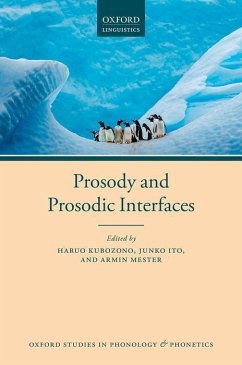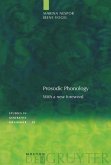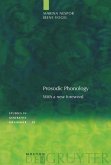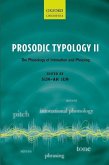Prosody and Prosodic Interfaces
Herausgeber: Kubozono, Haruo; Mester, Armin; Ito, Junko
Prosody and Prosodic Interfaces
Herausgeber: Kubozono, Haruo; Mester, Armin; Ito, Junko
- Gebundenes Buch
- Merkliste
- Auf die Merkliste
- Bewerten Bewerten
- Teilen
- Produkt teilen
- Produkterinnerung
- Produkterinnerung
This volume brings together new work on prosody and prosodic interfaces from international experts in the field, with parts exploring word prosody and phrase prosody, lexical tone and intonation, and the syntax-prosody interface. The empirical data comes from a wide range of languages, including many that are largely undocumented or understudied.
Andere Kunden interessierten sich auch für
![Prosodic Phonology Prosodic Phonology]() Marina NesporProsodic Phonology50,99 €
Marina NesporProsodic Phonology50,99 €![Prosodic Phonology Prosodic Phonology]() Marina NesporProsodic Phonology194,95 €
Marina NesporProsodic Phonology194,95 €![Prosodic Features and Prosodic Structure Prosodic Features and Prosodic Structure]() Anthony FoxProsodic Features and Prosodic Structure278,99 €
Anthony FoxProsodic Features and Prosodic Structure278,99 €![Prosodic Typology II Prosodic Typology II]() Prosodic Typology II134,99 €
Prosodic Typology II134,99 €![Prosodic Categories: Production, Perception and Comprehension Prosodic Categories: Production, Perception and Comprehension]() Prosodic Categories: Production, Perception and Comprehension118,99 €
Prosodic Categories: Production, Perception and Comprehension118,99 €![Prosodic Orientation in English Conversation Prosodic Orientation in English Conversation]() Beatrice Szczepek ReedProsodic Orientation in English Conversation117,99 €
Beatrice Szczepek ReedProsodic Orientation in English Conversation117,99 €![Prosodic Patterns in English Conversation Prosodic Patterns in English Conversation]() Nigel G WardProsodic Patterns in English Conversation101,99 €
Nigel G WardProsodic Patterns in English Conversation101,99 €-
-
-
This volume brings together new work on prosody and prosodic interfaces from international experts in the field, with parts exploring word prosody and phrase prosody, lexical tone and intonation, and the syntax-prosody interface. The empirical data comes from a wide range of languages, including many that are largely undocumented or understudied.
Produktdetails
- Produktdetails
- Verlag: Oxford University Press, USA
- Seitenzahl: 566
- Erscheinungstermin: 12. August 2022
- Englisch
- Abmessung: 238mm x 163mm x 38mm
- Gewicht: 1043g
- ISBN-13: 9780198869740
- ISBN-10: 0198869746
- Artikelnr.: 64363239
- Verlag: Oxford University Press, USA
- Seitenzahl: 566
- Erscheinungstermin: 12. August 2022
- Englisch
- Abmessung: 238mm x 163mm x 38mm
- Gewicht: 1043g
- ISBN-13: 9780198869740
- ISBN-10: 0198869746
- Artikelnr.: 64363239
Haruo Kubozono is Director of the National Institute for Japanese Language and Linguistics. His research interests range from speech disfluencies to speech prosody (accent and intonation) and its interfaces with syntax and information structure. He is the editor of The Handbook of Japanese Phonetics and Phonology (De Gruyter, 2015), The Phonetics and Phonology of Geminate Consonants (OUP, 2017), and Tonal Change and Neutralization (De Gruyter, 2018). Junko Ito is Professor in the Department of Linguistics at the University of California, Santa Cruz. Her research in phonology focuses on the morphophonemics and prosody of Japanese as it pertains to word structure and its phonological form. More recently, she has been working on issues surrounding the syntax-phonology interface, and on the structure of the phonological lexicon and its implications for the theory of grammar. Armin Mester is Research Professor of Linguistics at the University of California, Santa Cruz. His research is concerned with the principles organizing the prosodic structures found in language, as manifested in systems of syllabification, stress, and accent, and the mapping of syntactic and morphological structures onto prosodic form. He is pursuing this work in the context of Optimality Theory, with an additional interest in the basic architecture of the theory.
* Preface
* List of figures and tables
* List of abbreviations
* The contributors
* Introduction
* Part I: Word prosody and phrase prosody
* 1: Laura McPherson: Word tone is epiphenomenal: A case study from
Poko
* 2: José Ignacio Hualde: Accent shift and the reconstruction of Old
Common Basque accentuation
* 3: Draga Zec and Elizabeth Zsiga: Tone and stress as agents of
cross-dialectal variation: The case of Serbian
* 4: Sara Myrberg: Two-peakedness in South Swedish and the Scandinavian
tone accent typology
* 5: Larry M. Hyman: Prosodic asymmetries in nominal vs verbal phrases
in Bantu
* 6: Carlos Gussenhoven: How metrical is the Autosegmental-Metrical
model? Evidence from pitch accents in Nubi, Persian, and English
* Part II: Lexical tone and intonation
* 7: Ryan Bennett, Robert Henderson, and Megan Harvey: Tonal
variability and marginal contrast: Lexical pitch in Uspanteko
* 8: Gabriela Caballero, Yuan Chai, and Marc Garellek: Stress, tone,
and intonation in Choguita Rarámuri
* 9: Haruo Kubozono: Interactions between lexical and postlexical
tones: Evidence from Japanese vocative prosody
* 10: Yosuke Igarashi: Prosodic phrasing, long-distance rise, and
structural prominence marking in Japanese dialects without lexically
constrastive tones
* 11: Yuan Chai, Titus Kubri Kajo Kunda, Alejandro Rodríguez, and
Sharon Rose: Prosody of declaratives and questions in Rere (Koalib)
* Part III: The syntax-prosody interface
* 12: Seunghun J. Lee and Elisabeth Selkirk: Xitsonga tone: The
syntax-phonology interface
* 13: Gorka Elordieta and Elisabeth Selkirk: Unaccentedness and the
formation of prosodic structure in Lekeitio Basque
* 14: Shinichiro Ishihara: On the (lack of) correspondence between
syntactic clauses and intonational phrases
* 15: Jennifer Bellik, Junko Ito, Nick Kalivoda, and Armin Mester:
Matching and alignment
* References
* Index
* List of figures and tables
* List of abbreviations
* The contributors
* Introduction
* Part I: Word prosody and phrase prosody
* 1: Laura McPherson: Word tone is epiphenomenal: A case study from
Poko
* 2: José Ignacio Hualde: Accent shift and the reconstruction of Old
Common Basque accentuation
* 3: Draga Zec and Elizabeth Zsiga: Tone and stress as agents of
cross-dialectal variation: The case of Serbian
* 4: Sara Myrberg: Two-peakedness in South Swedish and the Scandinavian
tone accent typology
* 5: Larry M. Hyman: Prosodic asymmetries in nominal vs verbal phrases
in Bantu
* 6: Carlos Gussenhoven: How metrical is the Autosegmental-Metrical
model? Evidence from pitch accents in Nubi, Persian, and English
* Part II: Lexical tone and intonation
* 7: Ryan Bennett, Robert Henderson, and Megan Harvey: Tonal
variability and marginal contrast: Lexical pitch in Uspanteko
* 8: Gabriela Caballero, Yuan Chai, and Marc Garellek: Stress, tone,
and intonation in Choguita Rarámuri
* 9: Haruo Kubozono: Interactions between lexical and postlexical
tones: Evidence from Japanese vocative prosody
* 10: Yosuke Igarashi: Prosodic phrasing, long-distance rise, and
structural prominence marking in Japanese dialects without lexically
constrastive tones
* 11: Yuan Chai, Titus Kubri Kajo Kunda, Alejandro Rodríguez, and
Sharon Rose: Prosody of declaratives and questions in Rere (Koalib)
* Part III: The syntax-prosody interface
* 12: Seunghun J. Lee and Elisabeth Selkirk: Xitsonga tone: The
syntax-phonology interface
* 13: Gorka Elordieta and Elisabeth Selkirk: Unaccentedness and the
formation of prosodic structure in Lekeitio Basque
* 14: Shinichiro Ishihara: On the (lack of) correspondence between
syntactic clauses and intonational phrases
* 15: Jennifer Bellik, Junko Ito, Nick Kalivoda, and Armin Mester:
Matching and alignment
* References
* Index
* Preface
* List of figures and tables
* List of abbreviations
* The contributors
* Introduction
* Part I: Word prosody and phrase prosody
* 1: Laura McPherson: Word tone is epiphenomenal: A case study from
Poko
* 2: José Ignacio Hualde: Accent shift and the reconstruction of Old
Common Basque accentuation
* 3: Draga Zec and Elizabeth Zsiga: Tone and stress as agents of
cross-dialectal variation: The case of Serbian
* 4: Sara Myrberg: Two-peakedness in South Swedish and the Scandinavian
tone accent typology
* 5: Larry M. Hyman: Prosodic asymmetries in nominal vs verbal phrases
in Bantu
* 6: Carlos Gussenhoven: How metrical is the Autosegmental-Metrical
model? Evidence from pitch accents in Nubi, Persian, and English
* Part II: Lexical tone and intonation
* 7: Ryan Bennett, Robert Henderson, and Megan Harvey: Tonal
variability and marginal contrast: Lexical pitch in Uspanteko
* 8: Gabriela Caballero, Yuan Chai, and Marc Garellek: Stress, tone,
and intonation in Choguita Rarámuri
* 9: Haruo Kubozono: Interactions between lexical and postlexical
tones: Evidence from Japanese vocative prosody
* 10: Yosuke Igarashi: Prosodic phrasing, long-distance rise, and
structural prominence marking in Japanese dialects without lexically
constrastive tones
* 11: Yuan Chai, Titus Kubri Kajo Kunda, Alejandro Rodríguez, and
Sharon Rose: Prosody of declaratives and questions in Rere (Koalib)
* Part III: The syntax-prosody interface
* 12: Seunghun J. Lee and Elisabeth Selkirk: Xitsonga tone: The
syntax-phonology interface
* 13: Gorka Elordieta and Elisabeth Selkirk: Unaccentedness and the
formation of prosodic structure in Lekeitio Basque
* 14: Shinichiro Ishihara: On the (lack of) correspondence between
syntactic clauses and intonational phrases
* 15: Jennifer Bellik, Junko Ito, Nick Kalivoda, and Armin Mester:
Matching and alignment
* References
* Index
* List of figures and tables
* List of abbreviations
* The contributors
* Introduction
* Part I: Word prosody and phrase prosody
* 1: Laura McPherson: Word tone is epiphenomenal: A case study from
Poko
* 2: José Ignacio Hualde: Accent shift and the reconstruction of Old
Common Basque accentuation
* 3: Draga Zec and Elizabeth Zsiga: Tone and stress as agents of
cross-dialectal variation: The case of Serbian
* 4: Sara Myrberg: Two-peakedness in South Swedish and the Scandinavian
tone accent typology
* 5: Larry M. Hyman: Prosodic asymmetries in nominal vs verbal phrases
in Bantu
* 6: Carlos Gussenhoven: How metrical is the Autosegmental-Metrical
model? Evidence from pitch accents in Nubi, Persian, and English
* Part II: Lexical tone and intonation
* 7: Ryan Bennett, Robert Henderson, and Megan Harvey: Tonal
variability and marginal contrast: Lexical pitch in Uspanteko
* 8: Gabriela Caballero, Yuan Chai, and Marc Garellek: Stress, tone,
and intonation in Choguita Rarámuri
* 9: Haruo Kubozono: Interactions between lexical and postlexical
tones: Evidence from Japanese vocative prosody
* 10: Yosuke Igarashi: Prosodic phrasing, long-distance rise, and
structural prominence marking in Japanese dialects without lexically
constrastive tones
* 11: Yuan Chai, Titus Kubri Kajo Kunda, Alejandro Rodríguez, and
Sharon Rose: Prosody of declaratives and questions in Rere (Koalib)
* Part III: The syntax-prosody interface
* 12: Seunghun J. Lee and Elisabeth Selkirk: Xitsonga tone: The
syntax-phonology interface
* 13: Gorka Elordieta and Elisabeth Selkirk: Unaccentedness and the
formation of prosodic structure in Lekeitio Basque
* 14: Shinichiro Ishihara: On the (lack of) correspondence between
syntactic clauses and intonational phrases
* 15: Jennifer Bellik, Junko Ito, Nick Kalivoda, and Armin Mester:
Matching and alignment
* References
* Index








